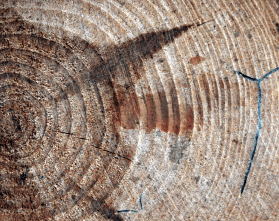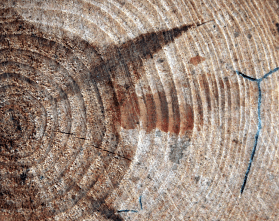Yes, it is true not all wood posts are the same. Different species of wood will last longer than others and some are better to use if you are hydraulically driving a post vs hand setting a post. By learning the differences you will be able to choose the best wood post for your needs.
First, all wood posts have both heartwood and sap wood. Heartwood is the core center of the post and is what gives the post its strength. The outer rings of the post are called sap wood and allow the post to accept treatment against rot, decay and termite damage. A post needs both heartwood and sap wood to be a good post.
A larger percentage of heartwood will make the post stronger, but then the sapwood would be less and possibly not accept as much chemical treatment against rot, decay and termite damage and the post would not last as long.
A larger amount of sap wood allows post to accept treatment, however this means the heartwood would be smaller so the post would not be as strong.
It is a tricky balance.
Dissection of a wood post:
 The inside of a wood post
The inside of a wood post
Heart Wood is the center of the tree/post. It is darker in color and the heart wood is not treatable. Heart wood is also more decay resistant.
Sap Wood is the outer portions of the tree. It is lighter in color and highly treatable. Sap wood has little or no decay resistance.
Transition Wood is the outside appearance of sap wood. Difficult to treat. Found between the heartwood and the sap wood.
Spring Wood is the light-colored portion of the growth ring. Usually wider than the summer wood.
Summer Wood is the darker portion of the growth ring. Summer wood is usually narrower than spring wood. The wider the summer ring is the stronger the post will be. Next, you need to consider the shape of the post.
Next, you need to consider the shape of the post.
Round or Square posts?
We have often been asked this question. Our recommendation is round because of greater strength. Think of a tree as round the rings of the tree are fully connected.
 Square or Round Post?
Square or Round Post?
The tree gets its strength from that full circle and so does the post. If you have a square post, depending on the diameter of the post it may not have full rings so strength can be marginal. Square posts can be challenging if hydraulically driving because they tend to twist.
What to look at when purchasing a wood post to build a fence
- Species
- Location of Growth
- Knots
- Types of wood in the post
- Form
- Treatment
- Diameter
- Length
- Installation Type
- Brace Assemblies
- Size for Number of Wires
Species, Form, Location of Growth & Knots:
There are many species of wood posts. Some of the most common in the Eastern part of the United States are
- Southern Yellow Pine
- Red Pine
- Locust
- Cedar
Different species of wood posts have different characteristics. A Locust post is probably what your Great Grandfather used years ago, cut from his own farm. They knew what time of year to cut the tree, they knew how old the tree needed to be before cutting it, they even knew how long to allow the cut wood to season before use. This same knowledge would have been used for making Cedar posts as well.
Southern yellow pine posts are grown mostly south of the Mason Dixon line and typically grow at a rate of 1-2 feet per year. The growth cycle produces ideal growth rings at a pace that produces good heartwood and sap wood ratio. This species has the best ratio of heartwood to sapwood. The rings on this tree are sporadic.
Red pine posts grown north of the Mason Dixon line. These posts are not as dense as a Southern Yellow Pine- thus they are not as strong. If the tree is grown further north the growing season can change the amount of heartwood and sap wood ratio. One of the main differences is the way the knots form on the tree. The knots grow in a ring around the tree. These knots effect the strength and if hydraulically driving a post keep in mind they can break easier.
 The inside of a wood post
The inside of a wood post
Form:
There are basically 2 forms of wood posts, tapered or perfect. There can be different names for these in the industry but they mean this;
Tapered is the traditional fence post. A post that say 4-5” x 7’ would mean that the post at the small end would be no smaller than 4” but could range up to 5” at the small end and no more than 5” at the large end. The 7’ would mean 7’ in length.
A perfect post would go through an extra process at the mill and it would mill the post to be perfectly round in shape. This process shaves off the bumps to make the post perfectly round. Now this extra process will make them look great, but it could possibly shave off more than you want and weaken the post or break the growth rings. Here is a perfect post description 4” x 7’ would mean 4” in diameter from small end to large end, no variance and 7’ in length.
Like we said not all posts are made the same, we have covered species, location of growth, knots, types of wood in the post, and form knowing the differences in these areas can help you start to narrow down your choices when it comes to planning your fencing project!
In the next part of this blog we will cover how treatment, diameter, and length can help you determine what post is right for you!
For additional assistance to ensure you are using the correct diameter and length of post contact your Kencove Product Specialist at 800-536-2683.
Disposal of Treated Wood: DISPOSE IN A LAND FILL, DO NOT BURN TREATED WOOD DO NOT SPREAD ASH OR DUST FROM TREATED WOOD ONTO GARDENS,WASH YOUR HANDS AFTER HANDLING TREATED WOOD AND BEFORE EATING OR DRINKING COMMON SENSE PRECAUTIONS




